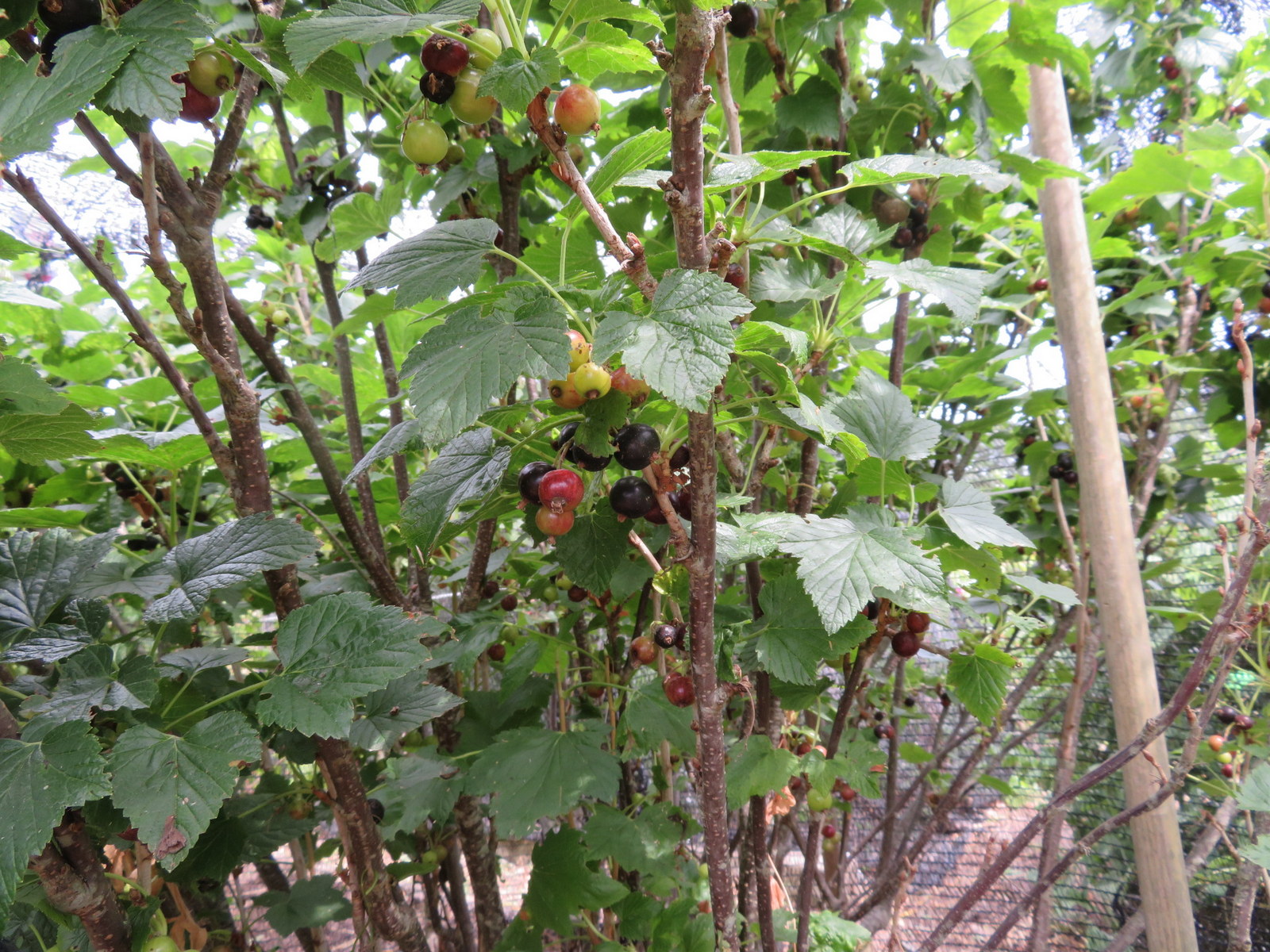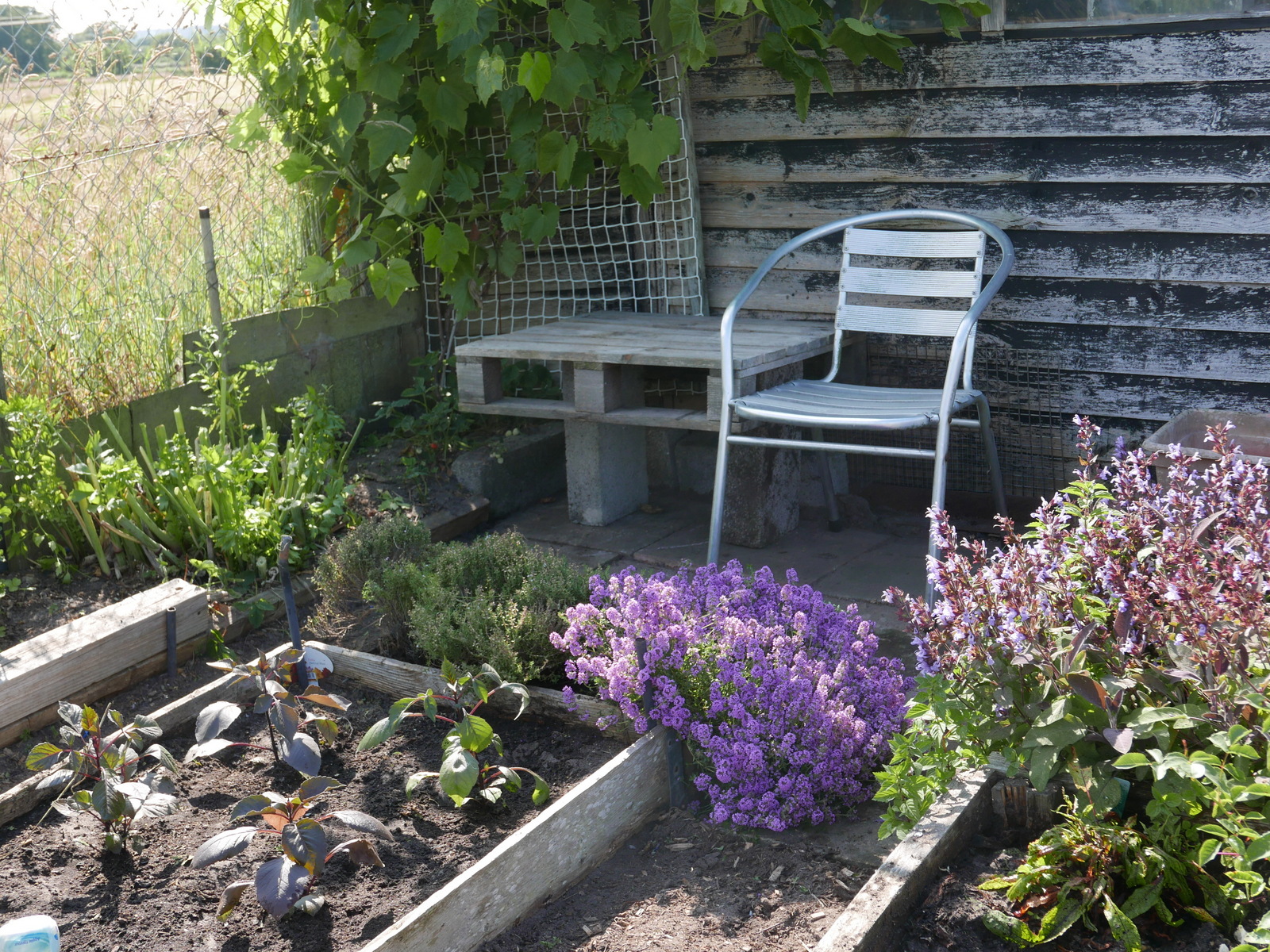- Growing Malope Trifida ‘Vulcan’ From Seed. – Higgledy Garden
- Late Summer & Early Autumn Sowing Of Hardy Annual Flower Seeds. – Higgledy Garden
Thursday, 18 July 2019
Wednesday, 17 July 2019
Wednesday, 3 July 2019
How To Grow Thyme (Step-by-Step)



How to do it
The method for crack planting depends on which plants you want.
Chamomile 'Treneague' and named varieties of thyme will not come true from seed, so buy a few plants and split them (unless, where the chamomile's concerned, you buy small plug plants that are ready to be pushed into gaps).
I have found it impossible to find Corsican mint seeds, too, so split that as well.
Splitting need not be difficult, because these plants naturally run across the surface of compost and root as they go, in effect creating lots of small plants that need to be severed from each other.
Water thoroughly first, then tip the plant out of its pot and look across the surface to see that the stems are rooted into the ground.
If they are, snip the plant into sections, each with a bit of stem and a bit of root (you may need to chop off the bulk of the roots first, but they should grow back).
Push the pieces into your cracks and pack around them with compost before watering well and continuing to water frequently.
Some will take; others will die.
Expect some losses.
For my own back path I'm going straight and true (and cheap) with a packet of pink-flowered creeping Thymus serphyllum seeds.
With seeds, the cracks must be prepared first: pour on a fairly fine and lump-free compost and brush it in.
Then sprinkle the seeds along the cracks, water in, and remember to water every few days in dry weather until the plants are established.
- Gardens: plants for cracks | Life and style | The Guardian
- How To Grow Thyme (Step-by-Step) - gardenersworld.com - BBC Gardeners' World Magazine
- Great Varieties of Thyme to Grow - BBC Gardeners' World Magazine
Tuesday, 25 June 2019
Abutilon megapotamicum.
- 365 Days.: Crichel House, Moor Crichel in Dorset, England.


Abutilon megapotamicum is a graceful shrub, native to the dry mountain valleys of Brazil.
Slender stems are hung with showy, lantern-shaped flowers over a long season.
It’s the perfect choice for a cool conservatory or for growing in a container on a sunny patio, that can be brought under cover in winter.
It may also be grown against a warm wall with shelter from cold winds and frost.
The Royal Horticultural Society has given it its prestigious Award of Garden Merit (AGM).
Grow Abutilon megapotamicum in moist but well-drained soil in a sunny, sheltered spot.
Propagate from summer cuttings, as an insurance against winter damage, especially since the shrubs can be short-lived.
Trim back after flowering.
- Abutilon megapotamicum - BBC Gardeners' World Magazine


Abutilon megapotamicum is a graceful shrub, native to the dry mountain valleys of Brazil.
Slender stems are hung with showy, lantern-shaped flowers over a long season.
It’s the perfect choice for a cool conservatory or for growing in a container on a sunny patio, that can be brought under cover in winter.
It may also be grown against a warm wall with shelter from cold winds and frost.
The Royal Horticultural Society has given it its prestigious Award of Garden Merit (AGM).
Grow Abutilon megapotamicum in moist but well-drained soil in a sunny, sheltered spot.
Propagate from summer cuttings, as an insurance against winter damage, especially since the shrubs can be short-lived.
Trim back after flowering.
- Abutilon megapotamicum - BBC Gardeners' World Magazine
Sunday, 23 June 2019
Thursday, 13 June 2019
Wednesday, 15 May 2019
Raspberry: growing, planting, pruning and tips on caring.
- strawberries have a useful life of three to five years.
Raspberries, on the other hand, are immortal.
There are many variations on the recipe, but essentially it’s just all your favourite Scottish ingredients – toasted oatmeal, whisky, raspberries, heather honey and cream – mixed or layered together.



- Raspberry 'Joan J'
10 Canes per bundle. Late fruiting variety, early for primocane, starting to pick in late July to October. High yielding, Lge fruit of good flavour. Spineless canes. Cut down late Nov-March. Supplied Bare Root, availbale from November to Feburary
£ 12.00
- Rubus idaeus 'Joan J' (PBR) (F) | raspberry 'Joan J'/RHS Gardening
'Joan J' is an autumn-fruiting cultivar with upright, spine-free canes that produce a good crop of red berries with good size and flavour.
Mulch with acidic material such as composted bark.
Prune all canes to ground level in late winter
- BBC Two - Gardeners' World, 2018, Episode 2, How to plant raspberries
- A foolproof guide to growing raspberries - Telegraph
The most popular raspberry varieties are summer-fruiting.
Like their close relative the blackberry, the canes are essentially biennial, growing one year and fruiting the next.
Thus, fruit is produced in summer, following on directly from the strawberry season.
But there is another type of raspberry that fruits in autumn, and this is the one I want to try to persuade you to grow, for several reasons:
- Summer raspberries are simple enough to grow, but there’s always that awkward moment when you have to cut down the fruited canes while leaving the new canes to fruit next year. It is surprisingly easy, crawling around with secateurs in hand, to snip accidentally through one of the new canes. But, since autumn raspberries grow and fruit in a single season, you simply cut the whole lot down and new ones spring forth.
What could be simpler?
Gardening books generally recommend cutting the old canes down in late winter, but why, for heaven’s sake?
The tradition in the Thompson garden is to pick the last raspberries on November 5, cut down the canes and throw them straight on the annual bonfire.
Job done, and nothing to do until you start picking again the following August.
The RHS recommends tying canes individually to a wire support, and summer-fruiting varieties do need this to survive winter gales.
Here again, however, autumn varieties are easier — I just have a length of old washing-line tied round posts at the four corners of my row, and that’s all the support they need.
If you grow short, sturdy 'Autumn Bliss’ in a sheltered spot you might well manage without any support at all.
One thing’s for sure — the elaborate structure you may have seen Monty Don using on Gardeners’ World for his raspberries is unnecessary for the autumn variety.
The main reason you’re advised to replace raspberry canes every 10 years or so is to prevent a build-up of viruses and other diseases.
But autumn varieties tend to be disease-free since the long period without canes helps to reduce the “bridge” between seasons that encourages diseases to keep going.
Autumn raspberries are out of sync with the dreaded raspberry beetle, so it’s rare to find maggots in your fruit.
Raspberries tend to be less damaged by birds than strawberries anyway, and autumn varieties are particularly trouble-free; bird damage to my raspberries is negligible.
- Planting out raspberry canes... again - Mail Online - David Derbyshire's Allotment Blog
Raspberries, on the other hand, are immortal.
There are many variations on the recipe, but essentially it’s just all your favourite Scottish ingredients – toasted oatmeal, whisky, raspberries, heather honey and cream – mixed or layered together.



- Raspberry 'Joan J'
10 Canes per bundle. Late fruiting variety, early for primocane, starting to pick in late July to October. High yielding, Lge fruit of good flavour. Spineless canes. Cut down late Nov-March. Supplied Bare Root, availbale from November to Feburary
£ 12.00
- Rubus idaeus 'Joan J' (PBR) (F) | raspberry 'Joan J'/RHS Gardening
'Joan J' is an autumn-fruiting cultivar with upright, spine-free canes that produce a good crop of red berries with good size and flavour.
Mulch with acidic material such as composted bark.
Prune all canes to ground level in late winter
- BBC Two - Gardeners' World, 2018, Episode 2, How to plant raspberries
- A foolproof guide to growing raspberries - Telegraph
The most popular raspberry varieties are summer-fruiting.
Like their close relative the blackberry, the canes are essentially biennial, growing one year and fruiting the next.
Thus, fruit is produced in summer, following on directly from the strawberry season.
But there is another type of raspberry that fruits in autumn, and this is the one I want to try to persuade you to grow, for several reasons:
- Summer raspberries are simple enough to grow, but there’s always that awkward moment when you have to cut down the fruited canes while leaving the new canes to fruit next year. It is surprisingly easy, crawling around with secateurs in hand, to snip accidentally through one of the new canes. But, since autumn raspberries grow and fruit in a single season, you simply cut the whole lot down and new ones spring forth.
What could be simpler?
Gardening books generally recommend cutting the old canes down in late winter, but why, for heaven’s sake?
The tradition in the Thompson garden is to pick the last raspberries on November 5, cut down the canes and throw them straight on the annual bonfire.
Job done, and nothing to do until you start picking again the following August.
The RHS recommends tying canes individually to a wire support, and summer-fruiting varieties do need this to survive winter gales.
Here again, however, autumn varieties are easier — I just have a length of old washing-line tied round posts at the four corners of my row, and that’s all the support they need.
If you grow short, sturdy 'Autumn Bliss’ in a sheltered spot you might well manage without any support at all.
One thing’s for sure — the elaborate structure you may have seen Monty Don using on Gardeners’ World for his raspberries is unnecessary for the autumn variety.
The main reason you’re advised to replace raspberry canes every 10 years or so is to prevent a build-up of viruses and other diseases.
But autumn varieties tend to be disease-free since the long period without canes helps to reduce the “bridge” between seasons that encourages diseases to keep going.
Autumn raspberries are out of sync with the dreaded raspberry beetle, so it’s rare to find maggots in your fruit.
Raspberries tend to be less damaged by birds than strawberries anyway, and autumn varieties are particularly trouble-free; bird damage to my raspberries is negligible.
- Planting out raspberry canes... again - Mail Online - David Derbyshire's Allotment Blog
Monday, 18 March 2019
Subscribe to:
Comments (Atom)


























